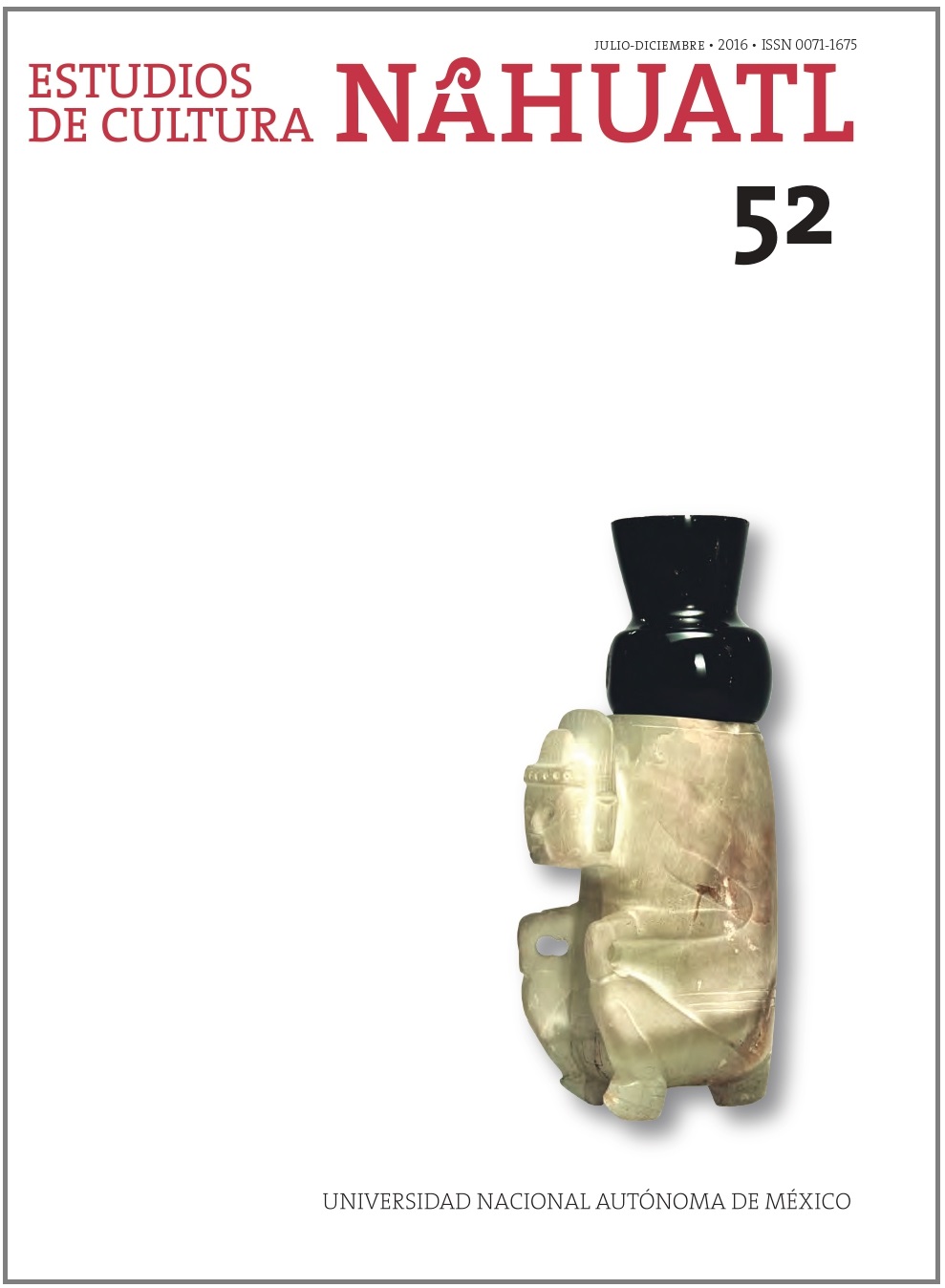Resumen
El presente ensayo examina el uso del monocromo en algunas ilustraciones del Códice florentino en relación con el tema tratado, el texto correspondiente y el diseño y desarrollo general de la obra. Sostiene que el monocromo fue una decisión consciente que permitió a los tlacuiloque expresar en términos meramente visuales cómo se incorporaron las tradiciones europeas a la religión e historia nahuas, tal como se presentan en la Historia general.
Citas
- Botta, Sergio, y Mario Campaña, “El politeísmo como sistema de traducción: la obra misionera de Toribio de Benavente Motolinía frente a la alteridad religiosa de la Nueva España”, Guaraguao, v. 12, n. 28, 2008, p. 9-26.
- Burkhart, Louise M., “The solar Christ in Nahuatl doctrinal texts of early colonial Mexico”, Ethnohistory, v. 35, n. 3, 1988, p. 234-256.
- ______, The slippery earth: Nahua-Christian moral dialogue in sixteenth-century Mexico, Tucson, University of Arizona Press, 1989.
- ______, “Flowery heaven: The aesthetic of Paradise in Nahuatl devotional literature”, RES: Anthropology and Aesthetics, n. 21, 1992, p. 88-109.
- Cline, S. L., “Revisionist conquest history: Sahagún’s revised Book XII”, en Jorge J. Klor de Alva, Henry B. Nicholson y Eloise Quiñones Keber (comps.),The work of Bernardino de Sahagún: Pioneer ethnographer of sixteenth-century Aztec Mexico, Albany, State University of New York, Institute of Mesoamerican Studies at Albany, 1988, p. 93-106.
- D’Olwer, Luis Nicolau, y Howard F. Cline, “Sahagún and his works”, en Howard F. Cline (comp.), Handbook of Middle American Indians, vol. 13 (Guide to ethnohistorical sources, Part two), Austin, University of Texas Press, 1973, p. 186-207.
- Edgerton, Samuel Y., Theaters of conversion: Religious architecture and Indian artisans in colonial Mexico, Albuquerque, University of New Mexico Press, 2001.
- Escalante Gonzalbo, Pablo, “El patrocinio del arte indocristiano”, en Gustavo Curiel (comp.), Patrocinio, colección y circulación de las artes, México, Universidad Nacional Autónoma de México, Instituto de Investigaciones Estéticas, 1997, p. 215-235.
- ______, “Iconografía y pintura mural en los conventos mexicanos”, en Felipe II y el arte de su tiempo, Madrid, Visor, 1998, p. 235-257.
- ______, “The painters of Sahagún’s manuscripts: Mediators between two worlds”, en John Frederick Schwaller (comp.), Sahagún at 500: Essays on the quintecenary of the birth of Fr. Bernardino de Sahagún, Berkeley, Academy of American Franciscan History, 2003, p. 167-191.
- Estrada de Gerlero, Elena Isabel, “La plumaria, expresión artística por excelencia”, en Elisa Vargaslugo (comp.), México en el mundo de las colecciones de arte. Nueva España, México, Grupo Azabache, 1994, p. 73-117.
- Fehrenbach, Frank, “Coming alive: Some remarks on the rise of ‘monochrome’ sculpture in the Renaissance”, Source: Notes on the History of Art, v. 30, n. 3, 2011, p. 47-55.
- Fernández, Miguel Ángel, y Mario de la Torre, La Jerusalén indiana: los conventos-fortaleza mexicanos del siglo XVI, México, Smurfit Cartón y Papel de México, 1992.
- Frenk, Margit, Entre la voz y el silencio, México, Fondo de Cultura Económica, 2005.
- García Icazbalceta, Joaquín, Bibliografía mexicana del siglo XVI: catálogo razonado de libros impresos en México de 1539 a 1600, México, Fondo de Cultura Económica, 1954.
- Garone Gravier, Marina, “Sahagún’s codex and book design in the indigenous context”, en Gerhard Wolf y Joseph Connors (comps.), Colors between two worlds: The Florentine Codex of Bernardino de Sahagún, Florencia, Kunsthistorisches Institut in Florenz, Max-Planck-Institut/Villa I Tatti, The Harvard University Center for Italian Renaissance Studies, 2011, p. 157-197.
- Grañén Porrúa, María Isabel, “El ámbito socio-laboral de las imprentas novohispanas: siglo XVI”, Anuario de Estudios Americanos, n. 48, 1991, p. 49-94.
- ______, “La transferencia de los grabados novohispanos del siglo XVI”, Historias, n. 31, 1993-1994, p. 99-111.
- Haly, Richard, “Bare bones: Rethinking Mesoamerican divinity”, History of Religions, v. 31, n. 3, 1992, p. 269-304.
- Hartog, François, El espejo de Heródoto: ensayo sobre la representación del otro, México, Fondo de Cultura Económica, 2002.
- Hvidfeldt, Arild, Teotl and ixiptlatli: Some central concepts in ancient Mexican religion, Copenhagen, Munskgaard, 1958.
- Latour, Bruno, “How to be iconophilic and science, art, and religion?”, en Carrie Jones y Peter Galison (comps.), Picturing science, producing art, Londres, Routledge, 1998, p. 418-440.
- León-Portilla, Miguel, “De la oralidad y los códices a la ‘Historia general’: transvase y estructuración de los textos allegados por fray Bernardino de Sahagún”, Estudios de Cultura Náhuatl, v. 29, 1999, p. 65-141.
- ______, La tinta negra y roja: antología de poesía náhuatl. Edición bilingüe, México, Era, 2013.
- León-Portilla, Miguel, Ángel María Garibay K. y Alberto Beltrán, Visión de los vencidos: relaciones indígenas de la Conquista, 29a. ed., México, Universidad Nacional Autónoma de México, Coordinación de Humanidades, 2007.
- Magaloni Kerpel, Diana, “Imágenes de la conquista de México en los códices del siglo XVI: una lectura de su contenido simbólico”, Anales del Instituto de Investigaciones Estéticas, n. 82, 2003, p. 5-45.
- ______, “Visualizing the Nahua/Christian dialogue: Images of the conquest in Sahagún’s Florentine Codex and their sources”, en John Frederick Schwaller (comp.), Sahagún at 500: Essays on the quintecenary of the birth of Fr. Bernardino de Sahagún, Berkeley, Academy of American Franciscan History, 2003, p. 193-221.
- ______, “Painters of the New World: The process of making the Florentine Codex”, en Gerhard Wolf y Joseph Connors (comps.), Colors between two worlds: The Florentine Codex of Bernardino de Sahagún, Florencia, Kunsthistorisches Institut in Florenz, Max-Planck-Institut/Villa I Tatti, The Harvard University Center for Italian Renaissance Studies, 2011, p. 47-76.
- ______, Los colores del Nuevo Mundo: artistas, materiales y la creación del Códice florentino, México, Universidad Nacional Autónoma de México/ The Getty Research Institute, 2014.
- Manrique, Jorge Alberto, “La estampa como fuente del arte en la Nueva España”, Anales del Instituto de Investigaciones Estéticas, v. 13, n. 50, 1982, p. 55-60.
- Mathes, W. Michael, “Humanism in sixteenth- and seventeenth-century libraries of New Spain”, Catholic Historical Review, v. 82, n. 3, 1996, p. 412-435.
- Nagel, Alexander, “Gifts for Michelangelo and Vittoria Colonna”, The Art Bulletin, v. 79, n. 4, 1997, p. 647-668.
- ______, Michelangelo and the reform of art, New York, Cambridge University Press, 2000.
- Olivier, Guilhem, “¿Modelos europeos o concepciones indígenas? El ejemplo de los animales en el libro XI del Códice florentino de fray Bernardino de Sahagún”, en José Rubén Romero Galván y Pilar Máynez (comps.), El universo de Sahagún: pasado y presente. Coloquio 2005, México, Universidad Nacional Autónoma de México, Instituto de Investigaciones Históricas, 2007, p. 125-139.
- ______, “El panteón mexica a la luz del politeísmo grecolatino: el ejemplo de la obra de fray Bernardino de Sahagún”, Studi e Materiali di Storia delle Religioni, v. 76, n. 2, 2010, p. 389-410.
- Palmeri Capesciotti, Ilaria, “La fauna del libro XI del Códice florentino de Bernardino de Sahagún: dos sistemas taxonómicos frente a frente”, Estudios de Cultura Náhuatl, v. 32, 2001, p. 189-221.
- Peterson, Jeanette Favrot, The Paradise garden murals of Malinalco: Utopia and empire in sixteenth-century Mexico, Austin, University of Texas Press, 1993.
- Philippot, Paul, “Les grisailles et les ‘degrés de réalité’ de l’image dans la peinture flamande des 15e et 16e siècles”, Bulletin des Musées Royaux des Beaux-Arts de Belgique, n. 15, 1966, p. 225-242.
- Pohl, John M. D., y Claire L. Lyons, The Aztec pantheon and the art of empire, Los Angeles, The J. Paul Getty Museum, 2010.
- Powell, Amy Knight, Depositions: Scenes from the late medieval church and the modern museum, New York, Zone Books, 2012.
- Quiñones Keber, Eloise, “Deity images and texts in the Primeros Memoriales and Florentine Codex”, en Jorge Klor de Alva, Henry B. Nicholson y Eloise Quiñones Keber (comps.), The work of Bernardino de Sahagún: Pioneer ethnographer of the sixteenth century, Albany, State University of New York at Albany, Institute for Mesoamerican Studies, 1988, p. 255-272.
- ______, “Reading images: The making and meaning of the Sahaguntine illustrations”, en Jorge Klor de Alva, Henry B. Nicholson y Eloise Quiñones Keber (comps.), The Work of Bernardino de Sahagún: Pioneer Ethnographer of Sixteenth-Century Aztec Mexico, Albany, State University of New York at Albany, Institute for Mesoamerican Studies, 1988, p. 199-210.
- ______, “Painting divination in the Florentine Codex”, en Eloise Quiñones Keber (comp.), Representing Aztec ritual: Performance, text, and image in the work of Sahagún, Niwot, University Press of Colorado, 2002, p. 251-276.
- Reyes Valerio, Constantino, Arte indocristiano, México, Instituto Nacional de Antropología e Historia, 2000.
- Robertson, Donald, Mexican manuscript painting of the early colonial period: The metropolitan schools, New Haven, Yale University Press, 1959.
- Russo, Alessandra, “Plumes of sacrifice: Transformations in sixteenth-century Mexican feather art”, RES: Anthropology and Aesthetics, n. 42, 2002, p. 226-250.
- Sahagún, Bernardino de, The Florentine Codex: General history of the things of New Spain, trad. de Arthur J. O. Anderson y Charles E. Dibble, Salt Lake City-Santa Fe, University of Utah Press and School of American Research, 1950-1982.
- Schoell-Glass, Charlotte, “En grisaille: Painting difference”, en Martin Heusser (comp.), Text and visuality: Word & image interactions 3, Amsterdam, Rodopi, 1999, p. 197-204.
- Taylor Baird, Ellen, “Sahagún’s Primeros Memoriales and Codex Florentino: European elements in the illustrations”, en J. Kathryn Josserand y Karen Dakin (comps.), Smoke and mist: Mesoamerican studies in memory of Thelma D. Sullivan, Oxford, BAR International Series, 1988, p. 15-40.
- Terraciano, Kevin, “Three texts in one: Book XII of the Florentine Codex”, Ethnohistory, v. 57, n. 1, 2010, p. 51-72.
- Wake, Eleanor, Framing the sacred: The Indian churches of early colonial Mexico, Norman, University of Oklahoma Press, 2010.
- Wasson, R. Gordon, George Cowan, Florence Cowan y Willard Rhodes (comps.), María Sabina and her Mazatec mushroom velada, New York, Harcourt Brace Jovanovich, 1974.
Cómo citar
Licencia
Derechos de autor 2016 Universidad Nacional Autónoma de México

Esta obra está bajo una licencia internacional Creative Commons Atribución-NoComercial-SinDerivadas 4.0.
- Resumen visto - 291 veces
- PDF descargado - 181 veces


 Estudios de Cultura Náhuatl se encuentra bajo una
Estudios de Cultura Náhuatl se encuentra bajo una 








